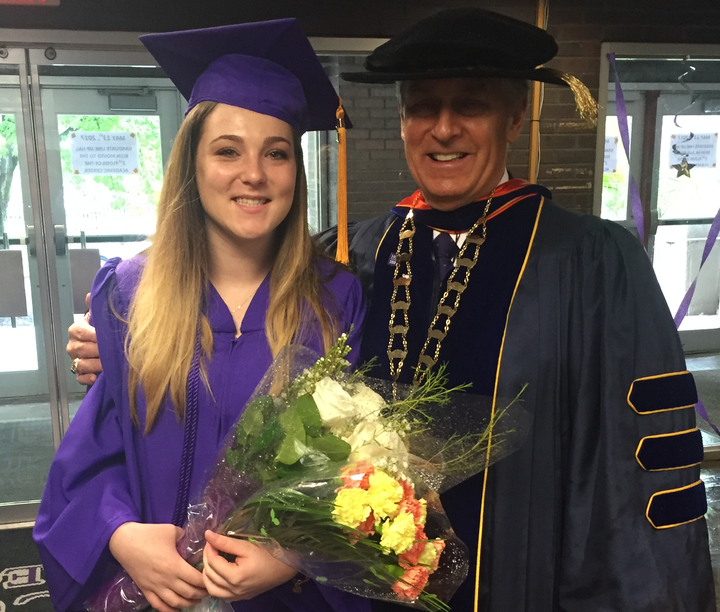
Annie FitzPatrick congratulated by Harcum College President, Dr. Jon Jay DeTemple.
It’s graduation season. If your child has reached this milestone, congratulations. You must be so proud.
Annie FitzPatrick attended one of the best public schools in Pennsylvania. She just graduated first in her class from Harcum College. Next year, she’s attending Drexel University to complete a bachelor’s degree in Environmental Science. That kind of resume makes any parent proud.
But Annie and her family have a different outlook about graduation. They’re just celebrating that she’s alive.
In February 2016, Annie was visiting a local convenient store. She collapsed. Fortunately, a couple of police officers were there with an automated external defibrillator (AED). The convenient store did not have one. The officers resuscitated her. At the hospital, she was diagnosed with Long QT Syndrome, and received an implantable cardioverter defibrillator (ICD).
Annie’s story presents us parents with two very serious questions.
How would we feel if our child died before graduation from a detectable and treatable heart condition?
How would we feel if our child died before graduation because the only tool that could’ve prevented her death was not available?
I apologize. These are grim scenarios to contemplate during this festive season. However, they are very real. Fortunately, they come with a solution. Since it is CPR/AED Awareness Week, let’s focus on the second question. You can grapple with the first question in one of my earlier blog posts.
Sudden cardiac arrest takes the lives of thousands of students every year. It is even more deadly among adults, taking over 300,000 lives every year. But it strikes many more and survivors, like Annie, don’t get counted in that number. You probably saw the recent story about the host of the Biggest Loser, Bob Harper, and his near death cardiac experience. Have you ever seen what sudden cardiac arrest looks like in school?
A few years back, Kylee Shea collapsed in the hallway of her middle school. Last year, Claire Crawford collapsed on the volleyball court. These stories have happy endings, but most don’t. The survival rate from sudden cardiac arrest is around 10%, and for each minute that defibrillation is delayed, the chance of survival decreases by 10%.
There is only one way to ensure these happy endings - an AED device. Sounds pretty simple, but, there is a big problem - schools don’t have them. Only fifteen states have legislation to address AEDs in schools and some of the laws only recommend the devices. They don’t require them.
Let’s put this in perspective. From 1998 - 2012, there were no reported fatalities from school fires. That could be because there were no fires. More likely, it is because schools are required to have one or more of the following: smoke detectors, sprinkler systems, fire alarms, fire extinguishers and water. Let’s not forget about the fire drills that prepare the faculty and students how to respond when there is a fire.
So what’s the deal? Why are the only lifesaving tools absent from our schools?
Some say it’s the liability. This is completely ignorant. Schools have a duty to protect our children from foreseeable dangers. I’m pretty sure that Kylee, Claire and this blog post make it easy to foresee this deadly scenario.
Others say it is the cost. I know that many schools are crumbling, understaffed and without the right materials. However, this doesn’t need to be a money issue. A new AED costs around $1,000. There are about 100,000 schools (elementary and secondary) in the United States. Let’s assume that none of them have an AED device. It would cost $100,000 to take a big step toward addressing this problem. It won’t solve the problem because some schools are really big and need more than one AED. They have more than one fire extinguisher, right? But, it puts us in a better position to save a life.
This should be easy. There are 3.5 million students graduating high schools right now. What if each family donated 3 cents to honor their big achiever? OK, there’s no way to manage that kind of collection effort. How about 100,000 families donate one dollar or 10,000 families donate $10?
How can we fix this problem since the solution is so attainable? There are three actions that you can take right now.
1. Call your State Representative or Senator. Get them to introduce a bill that requires AEDs in schools and youth-related facilities. You can see where your state stands at this site. Our friends in Massachusetts just got it done!
2. Find a group that donates AEDs and get your school on their list. There are lots of them around the country. Here are a few to get you started: Firehouse Subs Public Safety Foundation, Hopey’s Heart, Living for Zachary, Shocks, and the Wes Leonard Heart Foundation.
3. Visit GotAED. It is a crowdfunding site dedicated to getting AEDs in places where kids learn and play. Anyone can create a campaign. When you reach your campaign goal, an AED and wall cabinet is shipped directly to the school. My nonprofit, Simon’s Fund, is behind this initiative. Every dollar pledged goes toward the price of the AED, cabinet and shipping.
However, you get that AED, make sure that that your school implements a cardiac emergency response plan. Everyone needs to be prepared.
We’ve all heard these phrases uttered at a graduation. “It’s not the end, it is the beginning.” “This is the first day of the rest of your lives.” If we really believe these statements to be true, then let’s get serious about ensuring that our kids reach graduation and the future we’ve all been dreaming about. Congrats, Annie!
